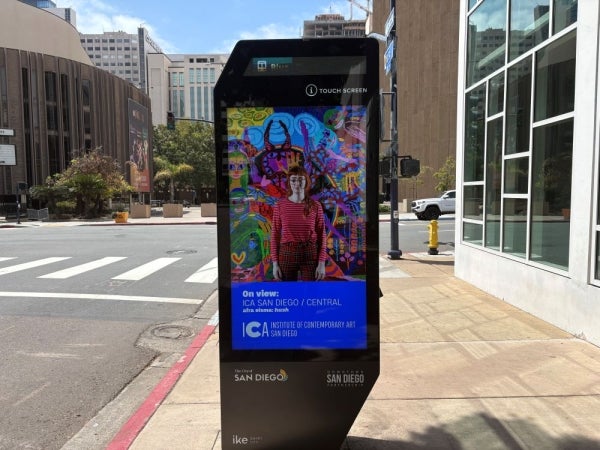Inclusive Engagement Techniques and Approaches
Information Kiosks

What is it?
An information kiosk is a stand-alone structure at a physical location designed to provide key project information to the public. It can be static and feature printed materials like flyers and maps or digital and interactive to feature things like videos or surveys.
When to use it
Kiosks can be useful throughout a project’s duration to share key information and materials to passersby. These can be used to increase public awareness about a project.
How to do it
Before
- Design the kiosk and choose an installation location that will meet the intended audience.
- For instance, for a project about improving public transportation options, work with MTS to determine feasibility of installing a temporary kiosk at a trolley station.
- Use existing kiosks when possible. Some organizations or businesses may have kiosks where City information could be displayed. The City of San Diego currently has a partnership with the Downtown San Diego Partnership and IKE Smart City for digital interactive kiosks throughout Downtown. Contact the Economic Development Department if there is a project of interest for the kiosks that would be relevant for people living, working or visiting in Downtown to learn about or engage in.
- Choose kiosk locations with high pedestrian activity or where people come together. For kiosks in the right-of-way, contact the asset-managing department (the department that manages the specific type of asset such as Library, Parks and Recreation, Transportation etc.) and determine if any permits are needed.
- For digital information kiosks, check that the location has adequate internet and/or power connections.
- Identify any outreach materials or input opportunities to be displayed at the kiosk such as:
During
- Set up the kiosk at the identified location following the manufacturer's instructions.
- Regularly check on the kiosk and update outreach materials with any new project information as needed.
Resource considerations
![]()
Cost: Minimal to Moderate
Utilizing existing kiosks can help reduce costs by repurposing available infrastructure. Purchasing or renting digital kiosks can be more costly.
![]()
Time: Moderate to High
Planning for new information kiosks can take several months, including the time required to obtain any necessary permits depending on the type of kiosk and location.
![]()
Capacity: Minimal
Information kiosks may require two people to plan and organize. Once the kiosk is set up, one person should be designated to monitor/update/replenish materials as needed.
How to make it more inclusive
- Translate kiosk material as needed based on community demographics.
- Place kiosks at an accessible height.
- Include audio output or screen reader compatibility to so people with limited vision and/or hearing can access the kiosk.
Inclusive Engagement Techniques and Approaches
- Introduction
- Appreciative Inquiry
- Arts-based Engagement
- Briefings
- Comment Forms
- Community Cafés
- Community Mapping
- Community Office Hours
- Email Notifications
- Engagement through Service
- Fact Sheets
- Flyers
- Focus Groups
- Game-based Approaches
- Hotlines
- Information Kiosks
- Interviews
- Meeting in a Box
- Mobile Engagement
- News Releases
- Newsletters
- Open Houses
- Participation Support
- Pop-Up Events
- Project Models
- Project-specific Groups
- Public Meetings
- Public Service Announcements (PSAs)
- Social Media
- Surveys and Polls
- Tours and Field Trips
- TV/Radio/Podcast Interviews
- Vision Walls
- Web-Based/Hybrid Meetings
- Webpages
- Workshops


 Inclusive Public Engagement Guide
Inclusive Public Engagement Guide